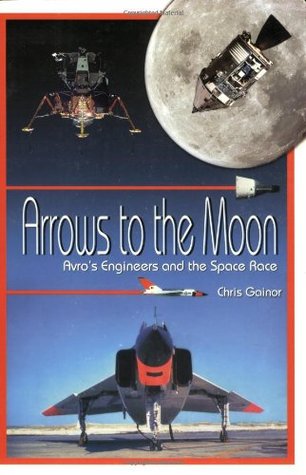20 February 2019: The 60th
Anniversary of "Black Friday",
The Day the Avro Arrow
was Cancelled
To many of us who were present at the time and have lived to see the
fallout thereof, 20 February 1959 is a “day that lives in infamy” because
thereafter Canadian defence research and development changed forever. Not
since has this country had the national resolve to undertake a project of
this magnitude and technical risk.
 Therefore this anniversary is an appropriate occasion to look
back to see what happened to the wonderful team that produced the Avro Arrow.
As is well known, many “Avroites” went south to the United States where they
took leading roles in the U.S. manned spaceflight program that was then just
getting underway. Their accomplishments are chronicled in Chris Gainor’s
2001 book, “Arrows to the Moon: Avro’s Engineers and the Space Race”. (Full
citation below.)
Therefore this anniversary is an appropriate occasion to look
back to see what happened to the wonderful team that produced the Avro Arrow.
As is well known, many “Avroites” went south to the United States where they
took leading roles in the U.S. manned spaceflight program that was then just
getting underway. Their accomplishments are chronicled in Chris Gainor’s
2001 book, “Arrows to the Moon: Avro’s Engineers and the Space Race”. (Full
citation below.)
As preamble, it is worth noting that the recruitment of Canadians for the
space program was not just a fortuitous accident. What does not seem to be
common knowledge is that senior United States officials knew exactly what was
happening at Avro Aircraft; they had been providing technical support and
program support for years. So the quality of the work and the quality of
the people were well known.
Nevertheless, Jim Chamberlain and Bob Lindley were key figures in this
process. They helped the NASA people select the engineers to be interviewed
and then helped expedite their recruitment and immigration to the United
States. This happened with unprecedented speed because NASA was indeed
desperate for senior engineers and engineering management.
Seventeen of the thirty-seven were born and raised in Canada. The rest
emigrated from the United Kingdom, reflecting the fact that A.V. Roe Canada
was a subsidiary of Hawker-Siddeley, a British company. (We must also
remember that it was standard practise in those days for Canadian aerospace
companies to recruit in England; they found a receptive audience among
British engineers seeking to escape the privations of life in post-war
England.)
With this background, this book is, in fact, a quite detailed history of
the American manned spaceflight program, from Mercury to the space station,
as seen through the eyes of the Canadians who participated. But in the
process of – rightly – concentrating on the Canadians, the dramatic thread is
somewhat downplayed. All of the major incidents are reported, such as the
Apollo 1 fire and the Apollo 13 rescue, but the fear and uncertainty these
incidents engendered does not always come through.
None of the Canadians were promoted to politically-visible top management
positions, but several, notably Jim Chamberlain, Owen Maynard and John Hodge,
occupied positions only one or two levels down and played vital roles in the
conception and execution of the program. Maynard and Hodge, along with many
others, were interviewed extensively for this book, but Chamberlain speaks
only through his accomplishments and the admiring words of others: he died of
a heart attack in 1981.
As one reads through the book, one of the things that really comes through
is the astonishing amount of new technology and new system concepts that had
to be developed from scratch. For the first time, scientists and engineers
were forced to think seriously in global terms rather than in piecemeal extensions of concepts that worked nationally. And it is freely
acknowledged that the Canadians made major contributions to these concepts
and their realization.
A most fascinating book. But as one reads through it, one cannot help
but be struck by the calibre of the technical and management talent that
Canada lost as a result of the cancellation of the Avro Arrow project, by
“What might have been.” Was the cancellation of the Arrow necessary? My
personal view is that it was a necessary decision at the time, but the
manner in which the project was terminated is a blot on our history from
which this country has never recovered.
“Arrows to the Moon: Avro’s Engineers and the Space Race”
Chris Gainor
Apogee Books, an imprint of Collector’s Guide Publishing, Burlington, Ontario, 2001
ISBN 1-896522-83-1

|

|
Last updated: 04 November 2018
|
 Therefore this anniversary is an appropriate occasion to look
back to see what happened to the wonderful team that produced the Avro Arrow.
As is well known, many “Avroites” went south to the United States where they
took leading roles in the U.S. manned spaceflight program that was then just
getting underway. Their accomplishments are chronicled in Chris Gainor’s
2001 book, “Arrows to the Moon: Avro’s Engineers and the Space Race”. (Full
citation below.)
Therefore this anniversary is an appropriate occasion to look
back to see what happened to the wonderful team that produced the Avro Arrow.
As is well known, many “Avroites” went south to the United States where they
took leading roles in the U.S. manned spaceflight program that was then just
getting underway. Their accomplishments are chronicled in Chris Gainor’s
2001 book, “Arrows to the Moon: Avro’s Engineers and the Space Race”. (Full
citation below.)